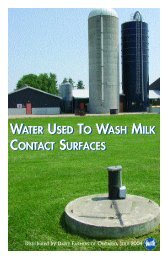Canadian Quality Milk On-Farm Food Safety Program - Centre ...
Canadian Quality Milk On-Farm Food Safety Program - Centre ...
Canadian Quality Milk On-Farm Food Safety Program - Centre ...
Create successful ePaper yourself
Turn your PDF publications into a flip-book with our unique Google optimized e-Paper software.
<strong>Canadian</strong> <strong>Quality</strong> <strong>Milk</strong><br />
• Finding out when they will most need the protection that vaccines provide.<br />
• Ensuring cattle are vaccinated according to the plan.<br />
For most dairy herds in Canada, a basic strategic program should include vaccinating<br />
breeding-age cows and heifers against BVD and IBR. The goal is to protect cows and<br />
heifers against abortions and other infertility problems caused by these two viruses.<br />
To ensure cattle are protected throughout pregnancy, they should be vaccinated before<br />
they are bred. Because protection is highest shortly after vaccination, heifers and<br />
cows will get the best protection if they are vaccinated in the months before they<br />
are bred.<br />
Your veterinarian may recommend vaccinating against other diseases such as Bovine<br />
Respiratory Syncytial Virus (BRSV), Parainfluenza 3 virus (PI3), Hemophilus somnus<br />
(HS), Pasteurellosis, Rabies, E. coli scours, Rotavirus, Coronavirus, coliform mastitis,<br />
Leptospirosis (Lepto) or Clostridial diseases such as blackleg in your herd's vaccination<br />
program. These recommendations will be based on a consideration of the special needs<br />
of your herd, and knowledge of which diseases occur locally. Producers should:<br />
Develop a written vaccination plan in consultation with the herd veterinarian. The<br />
plan should include:<br />
• Identification of specific disease-causing risks.<br />
• Which group is at risk.<br />
• When protection is most needed.<br />
Identify vaccinated animals and keep written records to ensure calves, breeding<br />
heifers, and cows are vaccinated according to the plan.<br />
Note: Vaccines may have milk or meat withdrawals. If a vaccine has a withdrawal,<br />
applications must be recorded on the livestock treatment record (Record 10). Vaccines<br />
must also be on the list of medicines and chemicals used on livestock (Record 9). See<br />
Chapter 4 for more details.<br />
Keep records which may include:<br />
• Name of the vaccine product used (including the lot or serial number and expiry<br />
date).<br />
• The date the vaccine was used.<br />
• Identification of the vaccinated cattle.<br />
• Any applicable milk or meat withdrawals.<br />
3.2.1.2 Managing Vaccines<br />
Store and use vaccines according to recommendations on the label. It is especially<br />
important to ensure that vaccines are properly refrigerated and stored in a dark<br />
place, such as a cooler.<br />
If using live vaccines, mix only enough to last for an hour or less.<br />
Discard any leftover vaccine.<br />
June 2010 3—5
















